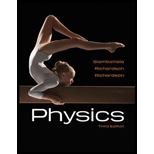
Concept explainers
(a)
The direction of the orientation of the field.
(a)
Answer to Problem 58P
The field is oriented vertically downward.
Explanation of Solution
Electric field is directed from positive charge (higher potential) to negative (lower potential). Thus, positively charged particle will move in the direction of the electric field and the negatively charged particle moves opposite direction of the electric field.
Since charge of the electron is negative, it passes through the parallel plates so the field must be oriented vertically downward direction.
Conclusion:
Therefore, the direction of the field is acting vertically downward.
(b)
The strength of the field between the parallel plates.
(b)
Answer to Problem 58P
The strength of the field between the parallel plates is
Explanation of Solution
Write the equation for the deflection time of the electron.
Here,
Write the equation for the deflection of the electron between the parallel plates.
Here,
Rearrange the equation (II) for
Write the expression for the electric force.
Here,
Write the equation for the Newton’s second law.
Here,
Conclusion:
Substitute the equation (I) in equation (III).
Compare the equation (IV) and (V) and rearrange for
Substitute the equation (VI) in the above equation.
Substitute
Therefore, the strength of the field between the parallel plates is
(c)
How much less will the electrons be deflected.
(c)
Answer to Problem 58P
The deflection distance of the electron is
Explanation of Solution
Write the equation for the deflection of the electrons due to gravitational force.
Here,
Substitute equation (I) in the equation (VII).
Conclusion:
Substitute
Therefore, the deflection distance of the electron is
Want to see more full solutions like this?
Chapter 16 Solutions
Physics - With Connect Access
 College PhysicsPhysicsISBN:9781305952300Author:Raymond A. Serway, Chris VuillePublisher:Cengage Learning
College PhysicsPhysicsISBN:9781305952300Author:Raymond A. Serway, Chris VuillePublisher:Cengage Learning University Physics (14th Edition)PhysicsISBN:9780133969290Author:Hugh D. Young, Roger A. FreedmanPublisher:PEARSON
University Physics (14th Edition)PhysicsISBN:9780133969290Author:Hugh D. Young, Roger A. FreedmanPublisher:PEARSON Introduction To Quantum MechanicsPhysicsISBN:9781107189638Author:Griffiths, David J., Schroeter, Darrell F.Publisher:Cambridge University Press
Introduction To Quantum MechanicsPhysicsISBN:9781107189638Author:Griffiths, David J., Schroeter, Darrell F.Publisher:Cambridge University Press Physics for Scientists and EngineersPhysicsISBN:9781337553278Author:Raymond A. Serway, John W. JewettPublisher:Cengage Learning
Physics for Scientists and EngineersPhysicsISBN:9781337553278Author:Raymond A. Serway, John W. JewettPublisher:Cengage Learning Lecture- Tutorials for Introductory AstronomyPhysicsISBN:9780321820464Author:Edward E. Prather, Tim P. Slater, Jeff P. Adams, Gina BrissendenPublisher:Addison-Wesley
Lecture- Tutorials for Introductory AstronomyPhysicsISBN:9780321820464Author:Edward E. Prather, Tim P. Slater, Jeff P. Adams, Gina BrissendenPublisher:Addison-Wesley College Physics: A Strategic Approach (4th Editio...PhysicsISBN:9780134609034Author:Randall D. Knight (Professor Emeritus), Brian Jones, Stuart FieldPublisher:PEARSON
College Physics: A Strategic Approach (4th Editio...PhysicsISBN:9780134609034Author:Randall D. Knight (Professor Emeritus), Brian Jones, Stuart FieldPublisher:PEARSON





